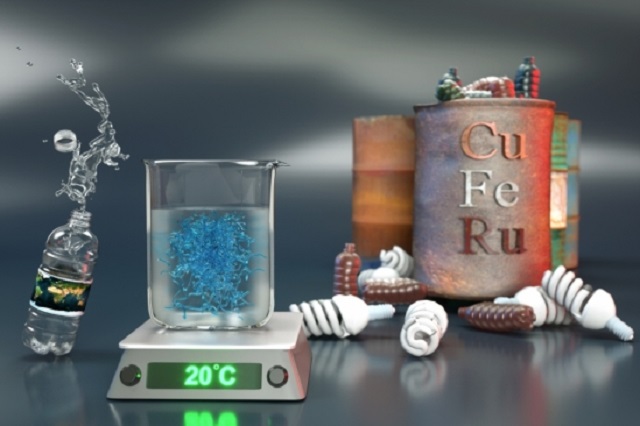 Photo Credit: Illustration by Peter Allen, UCSB
Photo Credit: Illustration by Peter Allen, UCSB
Researchers at the University of California, Santa Barbara and The Dow Chemical Company have collaborated to develop an innovative atom transfer radical polymerization (ATRP) process that may help overcome the hurdles that have so far prevented common use of controlled radical polymerization.
ATRP is an important process for producing polymers for different types of materials ranging from electronics to adhesives. It is an emerging technique and the various ATRP methods that are currently employed in the industry involve usage of metal catalysts. This is a major obstacle for use of this process in biomedical applications as metal contamination may occur.
The new, innovative ATRP process does not require heavy metal catalysts such as copper. An organic-based photocatalyst which requires light as stimulus for the controlled chemical reaction is used in this process.
The grand challenge in ATRP has been: How can we do this without any metals? We looked toward developing an organic catalyst that is highly reducing in the excited state, and we found it in an easily prepared catalyst, phenothiazine.
Craig Hawker, director of the Dow Materials Institute at UCSB
It’s ‘drop-in’ technology for industry. People are already used to the same starting materials for ATRP, but now we have the ability to do it without copper.
avier Read de Alaniz, principal investigator and professor of chemistry and biochemistry at UCSB
Copper is a conductor and hence it causes significant problems in microelectronics even when it is used in miniscule levels. Copper is toxic to cells and organisms, and hence cannot be used for biological applications.
ATRP is already used widely across dozens of major industries, but the new metal-free rapid polymerization process “pushes controlled radical polymerization into new areas and new applications,” according to Hawker. “Many processes in use today all start with ATRP. Now this method opens doors for a new class of organic-based photoredox catalysts.”
In order to synthesize functional block polymers, control of radical polymerization processes is very important. When phenothiazine functions like a catalyst it builds block copolymers sequentially so as to achieve high chain-end fidelity. This leads to an efficient process and also results in a versatile polymer structure.
Our process doesn’t need heat. You can do this at room temperature with simple LED lights. We’ve had success with a range of vinyl monomers, so this polymerization strategy is useful on many levels.
The development of living radical processes, such as ATRP, is arguably one of the biggest things to happen in polymer chemistry in the past few decades. This new discovery will significantly further the whole field.
Craig Hawker, director of the Dow Materials Institute at UCSB
A photoreactive Iridium catalyst had initially inspired this study, which was led by Read de Alaniz, Hawker, and Brett Fors. This study has been published in the Journal of the American Chemical Society as a paper titled “Metal-Free Atom Transfer Radical Polymerization.” Dow, who is a research partner, provided support for this study.
References